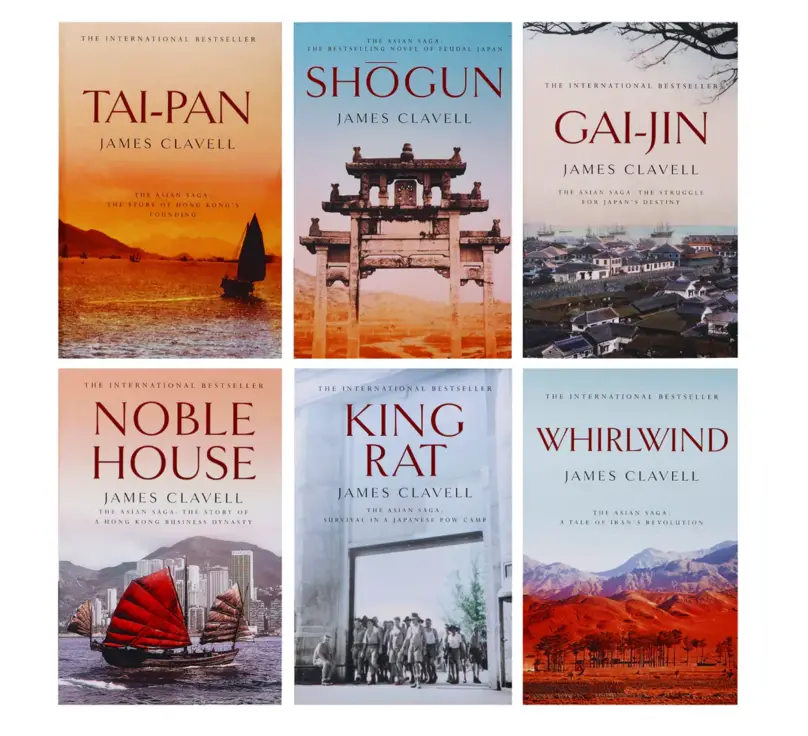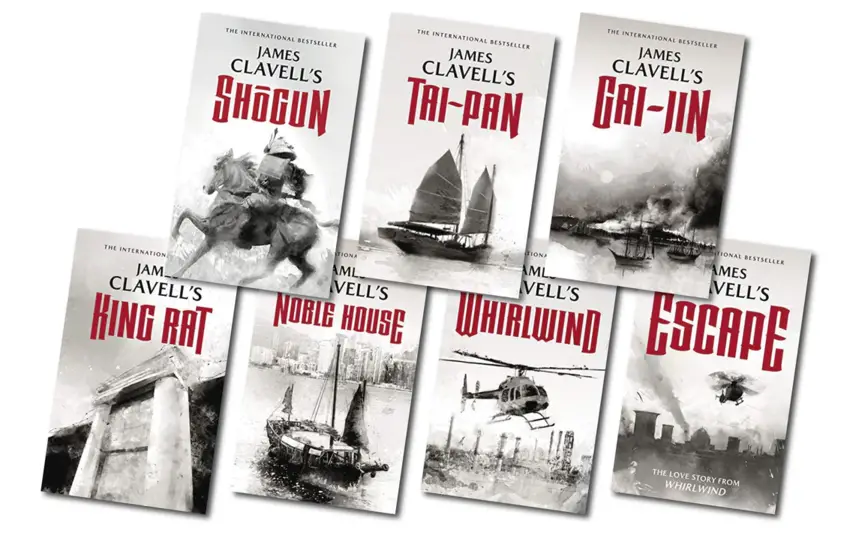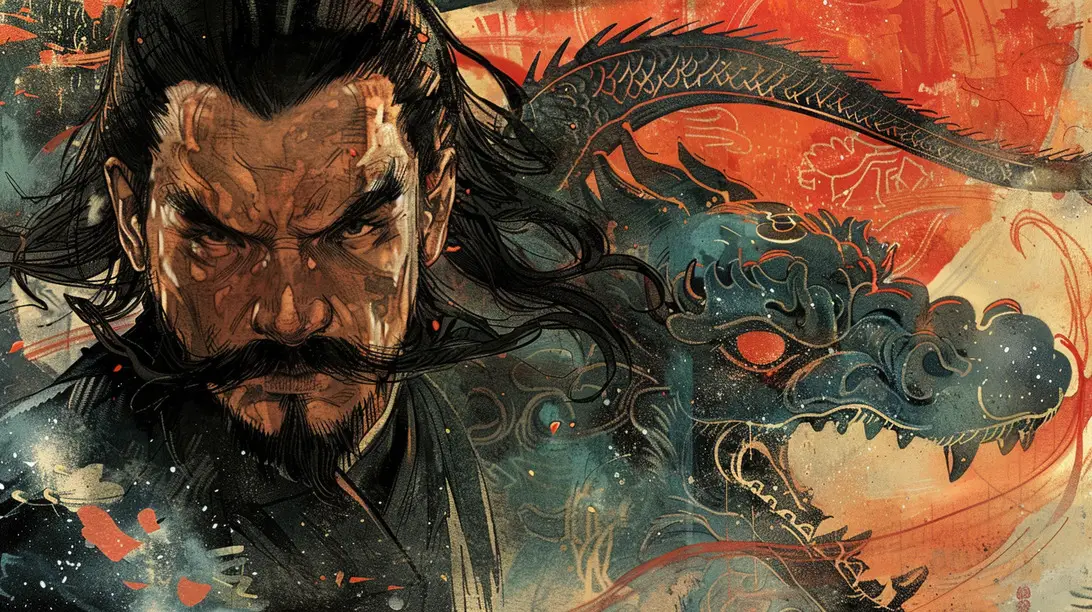James Clavell’s Asian Saga Order is a remarkable series of novels, spanning several centuries and exploring the interactions between the West and the East. It showcases Clavell’s deep understanding of Asian cultures and histories. Through his vivid storytelling and intricate character developments, Clavell offers a panoramic view of the historical events and personal dramas that shaped the Asian continent.
James Clavell’s Asian Saga Order in Order of Publication
King Rat (1962)
The series kicks off with “King Rat,” set in a Japanese POW camp during World War II. This novel, based on Clavell’s own experiences as a prisoner of war, explores themes of survival, power dynamics, and human resilience under extreme conditions. It introduces readers to Clavell’s world, where moral ambiguities and the will to survive push characters to their limits. “King Rat” is not just a story about a POW camp; it’s a narrative that delves into the essence of human nature when stripped of societal norms.
Tai-Pan (1966)
Following “King Rat,” “Tai-Pan” transports readers back to the 19th century, during the founding of Hong Kong, following the First Opium War. The novel centers around Dirk Struan, the ambitious and charismatic leader of the Noble House, as he navigates political intrigue, business rivalries, and personal vendettas. “Tai-Pan” is a thrilling exploration of colonial ambition, the clash of cultures, and the birth of one of the world’s most dynamic cities.
Shōgun (1975)
Perhaps the most renowned of Clavell’s works, “Shōgun” is set in the early 17th century and follows the journey of an English navigator, John Blackthorne, who becomes a pawn in the complex political games of feudal Japan. Through Blackthorne’s eyes, readers are introduced to the samurai code, the intricacies of Japanese society, and the transformation of an outsider into a key player in Japan’s history. “Shōgun” is a masterful tale of power, betrayal, and romance, offering a mesmerizing look at a pivotal moment in Japanese history. (Get the book from Amazon – link here.)
Noble House (1981)
Set in Hong Kong in the early 1960s, “Noble House” is a direct sequel to “Tai-Pan,” showcasing the modern-day struggles of the descendants of Dirk Struan. The novel is a massive, sprawling tale that weaves together corporate espionage, financial crises, and political intrigue, reflecting the volatile nature of international business and the unending ambition of the Noble House. “Noble House” is a testament to Clavell’s ability to craft a complex, engaging narrative that mirrors the complexities of real-world business warfare.
Whirlwind (1986)
“Whirlwind” shifts the saga to Iran in 1979, during the Islamic Revolution. This novel focuses on a group of helicopter pilots, their families, and their attempt to escape the country amid the chaos. Unlike its predecessors, “Whirlwind” explores the impact of political upheaval on individuals caught in the crossfire, offering a gripping account of survival, loyalty, and the human cost of conflict. It’s a poignant reminder of the personal stories behind historical events.
Gai-Jin (1993)
The saga concludes with “Gai-Jin,” which takes place in Japan in 1862, a time of great turmoil as the country faces internal strife and the pressures of Western influence. The novel follows the encounters between Japanese warlords, samurai, and European merchants, with the central figure being a half-English, half-Japanese heir to the Noble House. “Gai-Jin” is a richly detailed narrative that explores the collision of cultures and the dawn of a new era in Japan.
READ MORE: “Shogun” by James Clavell | 10 key narrative and thematic elements
James Clavell’s Asian Saga is an epic narrative that spans centuries, offering readers a window into the complex histories, cultures, and peoples of Asia. Through his vivid storytelling and complex characters, Clavell has created a series that not only entertains but educates, highlighting the nuances of East-West relations and the universal themes of power, ambition, and survival. As readers journey from the confines of a POW camp in “King Rat” to the tumultuous streets of 1862 Japan in “Gai-Jin,” they are treated to a masterclass in historical fiction, one that remains relevant and captivating decades after its completion.
James Clavell’s Asian Saga Order in chronological order of the events
Unlike the publication order, the internal chronological order of these novels provides a unique perspective on the evolution of Asian societies from feudal times to the modern era. This section explores the reading order based on the internal chronology of the novels, delving into the main theme of each book and how these themes interlace to offer a comprehensive view of historical and cultural transformations.
Shōgun: Feudal Japan, 1600
“Shōgun” serves as the gateway to Clavell’s Asian Saga, immersing readers in the intricate politics and societal structures of feudal Japan. The main theme revolves around the clash of cultures and the ensuing transformation. Through the eyes of an English navigator who becomes embroiled in the power struggles of samurai warlords, Clavell explores the possibility of mutual understanding and respect amidst vast cultural differences. “Shōgun” is a testament to the idea that from conflict and misunderstanding can arise a profound blend of cultures, leading to personal growth and change. (Get the book from Amazon – link here.)
Tai-Pan: Hong Kong, 1841
Following the establishment of Hong Kong after the First Opium War, “Tai-Pan” delves into the birth of Hong Kong and the relentless ambition that fueled its growth. The main theme centers on the foundation and perpetuation of empire through commerce, highlighting the fierce determination and cunning required to succeed in a land far from home. Through Dirk Struan’s endeavors, Clavell examines the complexities of leadership, the ethics of trade and colonialism, and the impact of individual ambition on the shaping of a city’s destiny.
Gai-Jin: Japan, 1862
Set in a period of great upheaval as Japan grapples with the pressures of foreign influence and internal conflict, “Gai-Jin” reflects on the theme of transition. It portrays the struggles of adapting to change while trying to maintain cultural identity. The interactions between Japanese samurai, European merchants, and the mixed-heritage protagonist symbolize the broader conflict between tradition and modernization, a theme that resonates with the challenges faced by societies undergoing rapid transformation.
King Rat: Singapore, 1945
“King Rat” shifts focus to survival and the human spirit amidst the dire conditions of a Japanese POW camp during World War II. Its main theme is the resilience of the human will in the face of adversity and the moral complexities that arise when survival is at stake. Clavell explores how power dynamics shift in extreme conditions, revealing the capacity for both nobility and deceit in the struggle to endure.
Noble House: Hong Kong, 1963
In “Noble House,” the main theme is the volatile nature of power and wealth in a globalized world. Set against the backdrop of 1960s Hong Kong, a financial and geopolitical hub, the novel examines the intricate dance of business, politics, and espionage. It portrays how fortunes can change with the wind, underscoring the precarious balance between success and ruin in the international arena.
Whirlwind: Iran, 1979
The saga concludes with “Whirlwind,” set during the Islamic Revolution in Iran, focusing on the theme of upheaval and the quest for freedom. Through the eyes of helicopter pilots and their families trying to escape the turmoil, Clavell addresses the impact of political revolution on individuals and the lengths to which people will go to secure their safety and principles. The novel is a poignant commentary on the cost of conflict and the enduring human desire for autonomy and peace.
READ MORE: James Clavell’s “Shogun” | The Ultimate Chapter Summaries
Conclusion
The internal chronological order of James Clavell’s Asian Saga offers a linear progression through history, from the feudal societies of Japan to the complex international dynamics of the 20th century. Each novel, with its distinct theme, contributes to a layered understanding of the interactions between East and West, the evolution of societies, and the universal human experiences of struggle, ambition, and the search for identity.
Reading the Asian Saga in this order not only provides a historical context but also allows readers to appreciate the intricate web of themes that Clavell masterfully weaves across different times and places, offering a rich tapestry of human history and cultural exchange.




